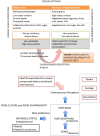The Role of the Japanese Traditional Diet in Healthy and Sustainable Dietary Patterns around the World
- PMID: 29401650
- PMCID: PMC5852749
- DOI: 10.3390/nu10020173
The Role of the Japanese Traditional Diet in Healthy and Sustainable Dietary Patterns around the World
Abstract
As incomes steadily increase globally, traditional diets have been displaced by diets that are usually animal-based with a high content of "empty calories" or refined sugars, refined fats, and alcohol. Dietary transition coupled with the expansion of urbanization and lower physical activity have been linked to the global growth in the prevalence of obesity, overweight and life style-related non-communicable diseases. The challenge is in how to reverse the trend of high consumption of less healthy food by more healthful and more environmentally sustainable diets. The increasing recognition that each individual has specific needs depending on age, metabolic condition, and genetic profile adds complexity to general nutritional considerations. If we were to promote the consumption of low-energy and low salt but nutritious diets, taste becomes a relevant food quality. The Japanese traditional diet (Washoku), which is characterized by high consumption of fish and soybean products and low consumption of animal fat and meat, relies on the effective use of umami taste to enhance palatability. There may be a link between Washoku and the longevity of the people in Japan. Thus Washoku and umami may be valuable tools to support healthy eating.
Keywords: Japanese cuisine; Washoku; dietary guidelines; glutamate; healthy dietary patterns; taste; taste receptors; traditional diets; umami; vegetables.
Conflict of interest statement
The authors are employees of Ajinomoto Co., Inc., which is a major producer of umami seasonings.
Figures


Similar articles
-
Science and technology of meat and meat products in Japan-Pursuit of their palatability under the influence of Washoku, traditional Japanese cuisine.Meat Sci. 2022 Oct;192:108919. doi: 10.1016/j.meatsci.2022.108919. Epub 2022 Jul 19. Meat Sci. 2022. PMID: 35901584 Review.
-
[Food Science of Dashi and Umami Taste].Yakugaku Zasshi. 2016;136(10):1327-1334. doi: 10.1248/yakushi.16-00057-1. Yakugaku Zasshi. 2016. PMID: 27725381 Review. Japanese.
-
Food nitrogen footprint reductions related to a balanced Japanese diet.Ambio. 2018 Apr;47(3):318-326. doi: 10.1007/s13280-017-0944-4. Epub 2017 Sep 14. Ambio. 2018. PMID: 28913773 Free PMC article.
-
Eating like there's no tomorrow: Public awareness of the environmental impact of food and reluctance to eat less meat as part of a sustainable diet.Appetite. 2016 Jan 1;96:487-493. doi: 10.1016/j.appet.2015.10.011. Epub 2015 Oct 23. Appetite. 2016. PMID: 26476397
-
Towards an environmentally sustainable and healthy Atlantic dietary pattern: Life cycle carbon footprint and nutritional quality.Sci Total Environ. 2019 Jan 1;646:704-715. doi: 10.1016/j.scitotenv.2018.07.264. Epub 2018 Jul 25. Sci Total Environ. 2019. PMID: 30059930
Cited by
-
Equity as a priority in EAT-Lancet-aligned food system transformations.Nat Food. 2024 Oct;5(10):811-817. doi: 10.1038/s43016-024-01047-1. Epub 2024 Oct 1. Nat Food. 2024. PMID: 39354117 Review.
-
The relationship between price and nutritional balance for young adults in the menus of Japanese restaurants.PeerJ. 2024 Sep 20;12:e18091. doi: 10.7717/peerj.18091. eCollection 2024. PeerJ. 2024. PMID: 39314849 Free PMC article.
-
Peripheral vascular dysfunction and the aging brain.Aging (Albany NY). 2024 May 22;16(10):9280-9302. doi: 10.18632/aging.205877. Epub 2024 May 22. Aging (Albany NY). 2024. PMID: 38805248 Free PMC article. Review.
-
Development of a Culinary Intervention (Cooking Class) for Salt Reduction in Japanese Home Cooking: Strategies and Assessment.AJPM Focus. 2024 Mar 13;3(3):100227. doi: 10.1016/j.focus.2024.100227. eCollection 2024 Jun. AJPM Focus. 2024. PMID: 38736567 Free PMC article.
-
Association between meal context and meal quality: an ecological momentary assessment in Japanese adults.Eur J Nutr. 2024 Sep;63(6):2081-2093. doi: 10.1007/s00394-024-03416-9. Epub 2024 May 3. Eur J Nutr. 2024. PMID: 38700576 Free PMC article.
References
MeSH terms
LinkOut - more resources
Full Text Sources
Other Literature Sources
Research Materials


